Isabel of Castile (1451 -1504), daughter of King Juan II of Castile and his second wife Isabella of Portugal, Isabel was born on April 22, 1451 in Madrigal de las Altas Torres (Avila) . However, there are many historians who have presented evidence, very worthy of being taken into account, that she was born in Madrid. As a child she was blonde, white, calm, devoted, nice. Over the years her hair darkened, she thickened, she lost part of her joy and sympathy, but she increased her prodigious spiritual energy. She was always quite rigid in her concept of her religion, bordering on intransigence.
Arrival of Isabella at court
King Don Juan died (Valladolid, 1454), his son Don Enrique IV took the throne, by his first wife, Doña María de Aragón, and therefore the stepbrother of the future Isabel I. She and her brother Don Alonso were imprisoned in Arévalo with his mother Doña Isabel. Many sad years. Many linked years of sorrows and shocks. The girl Isabel prays, reads ascetic books, dreams, pays effusive attention to her mother, in whom her madness begins to manifest her rigor. But her half-brother the king decided that Isabel and Alonso should go to the court, established in the city of Segovia . Because she thought how useful the marriage of her attractive and serious stepsister could be to her politics. she was about to contract a forced marriage with King Alfonso of Portugal . Shortly after, she endangered her future even more, since Don Enrique arranged for her to be married to the brutal, vicious and powerful knight Don Pedro Girón. Luckily, Providence, watching over such an honest maiden, determined that Don Pedro break "his neck", falling off the horse - which he was riding drunk - when he was on his way to Segovia in search of his coveted future wife. 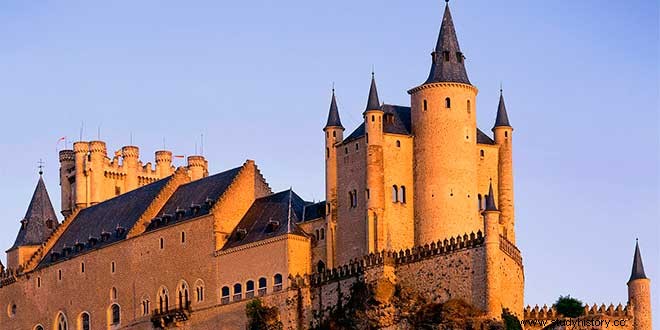
Agreement of the Bulls of Guisando
Isabel was only consoled for so many sorrows, so many shocks, by the presence of her by her side, her beloved brother Alonso. But this consolation soon ended, as Don Alonso died the following year in 1468 . And almost immediately the conspiracies began around another unfortunate creature:the princess Doña Juana, daughter of Enrique IV and his beautiful wife Doña Juana of Portugal; for there were many in Castile, nobles and commoners, who believed that Doña Juana was not the legitimate daughter of the monarch, but because of Doña Juana's adultery with the favorite Don Beltrán de la Cueva; hence they reviled her with the infamous description of Beltraneja. These nobles, when the infante Don Alonso died, took Isabel as their queen and swore to fight in her favor. But Isabel, showing sanity and respect for her half-brother, refused to call herself queen and even retired to the convent of Santa Ana, in Avila. .
At some point of deep embarrassment, deeply in love but very jealous of his wife, even making good — in part — the future qualification that the History of Impotent would give him, Don Enrique agreed to meet his sister Isabel at the Guisando Monastery (Avila ), in the limits of this province with that of Madrid. From this meeting came the so-called Pact of the Bulls of Guisando, agreed on September 18, 1468, and by which Isabel was considered as heir to the kingdom of Castile; consideration that led to the acceptance of the bastardy of the also beautiful and unfortunate Doña Juana .
Of course, the immediate consequence of the Pact was to marry Isabel. King Don Enrique intended two marriages:that of Isabel with King Alfonso V of Portugal and that of his heir, Prince Don Juan, with the bastard Doña Juana . The project failed. Because Isabel was in love with the crown prince of Aragon, Don Fernando... Helped effectively by Archbishop Carrillo and Admiral Don Fadrique Enriquez, Isabel sought refuge in Valladolid. At the same time, the prince of Aragon Don Fernando, disguised as a muleteer, entered Castile. And in the Vivero Palace they married on October 19, 1469 . Curious detail:Archbishop Carrillo, a permanent conspirator and subject of "vague morality", falsified the Papal Bull, in which the existing relationship between Isabel and Fernando was dispensed with.
New battle start in Castilla
It seems unnecessary to state that when he learned of this marriage, King Enrique "flew into a rage" and determined to "take great revenge." Which consisted of shouting that Doña Juana "la Beltraneja" was his legitimate daughter, and that only she was the heir to his kingdom. The shouts and the recognition of the monarch came late; and the unhappy princess found herself with very few defenders for her rights. Very few, but some of them powerful, intriguing to the point of obsession:the Marquis of Villena, Count Arévalo, and the dancing Archbishop Carrillo who had changed sides like someone changing his shirt . These powerful supporters of "la Beltraneja" were joined by King Alfonso of Portugal, whom Isabel had left "made up and without a girlfriend." Neither short nor lazy, Don Alfonso decided to take his girlfriend from his son and be the one who
contracted a betrothal —in Plasencia— with Doña Juana. Just celebrated which, Don Alfonso, at the head of brave hosts, entered Castile through Zamora y Toro . But in Toro he suffered an almost shameful defeat before the troops commanded by Don Fernando de Aragón himself. Possibly this event determined that the Cortes, meeting in Madrigal, recognized Isabel as the sole heiress of Don Enrique IV.
Isabel and Fernando kings of Castilla de Aragón
Shortly after, Isabel and Fernando, with a large army, marched to Extremadura, where the nobles and the archbishop in favor of «la Beltraneja» had taken refuge; because the king of Portugal had lightly fled from harassed roe deer to his inviolable lands . The Marquis of Villena was deprived of his lordship of Trujillo. For some time, the Portuguese pretensions about Castile still "coiled"; but when king Alfonso was defeated in Albuera 1479, he had to accept the Treaty of Alcozobes, in which both he and Juana «la Beltraneja» renounced their claims . And since in 1479 the King of Aragon Don Juan II died, and since 1474 —the year in which Enrique IV died— Elizabeth was Queen of Castile, in that year the crowns of Castile and Aragon were united. Taking advantage of that "clarita" in the internal wars and in the subversive policies, the monarchs decided to do battle in depth against the nobility, to deprive it of its abusive powers and feuds over more than half of Spain; since from the 10th to the 15th century, the monarchs owned less land and wealth than their nobles, whom they had to entertain and continue to give away if they wanted them to lend them men and money to continue the reconquest of all Spanish territory, much of the which the Muslims still possessed.
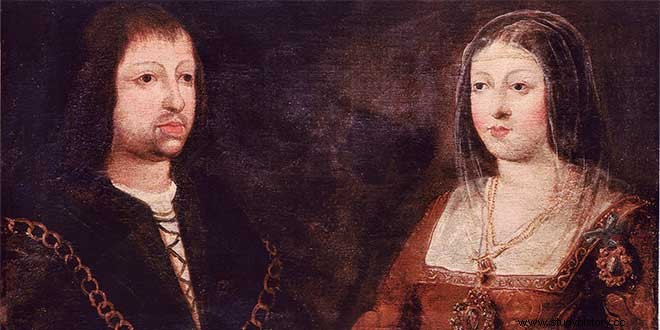
Realmstabilization
The problem was not easy at all for those monarchs who wanted to be the only ones ruling a great united people. They had to fight weapon in hand in Galicia, against rebellious nobles and prelates, and in Guipúzcoa against France, assimilate the Masterships of the Military Orders, pacify Andalusia, avoid the labyrinths that the audacious and mephistophelian Marquis of Villena had laid out for them… With tact , with energy, with flattery and favors, or with severity and punishment, little by little they managed to organize a legal Power without mediators. They went from one side to another across the map of Spain; Isabel on her white mare. In Seville their first son, Juan, was born to them, who, in addition to the natural heir, was the one who definitively thwarted the Portuguese invasion projects.
Spain, the first modern State
Isabel, while fighting, organized, unfolded her dream into realities, studied hard. She learned Latin and "almost" Greek. She legislated not without first having knowledge of the legal disciplines in force in the ancient kingdoms. And the powers of both spouses were delimited —in geographical unity. Under the unitary formula of Both rides, she rides so much, each one would manage her property. Isabel is queen of Castile, Fernando is king of Aragon. Thus it was the case that the discovery of America was carried out under the banners of Castilla y León, although it is considered a "general Spanish feat". For all of which, Isabel and Fernando — yokes and arrows for their shield — managed to organize the first modern State, with a Court that was also a model of perfect democracy .
Reconquest of the kingdom of Granada
But the State formula that the Catholic Monarchs implanted did not correspond to the integrity of the physical body of the nation. Spain was still divided. Fragments of what was once a powerful Caliphate of Córdoba still existed in its southern lands. It was necessary to put the finishing touch to the reconquest begun, centuries before, in an Asturian corner and in another Pyrenean corner. This brooch would not be closed as long as there were Muslims in the so-called kingdom of Granada . And against this kingdom Isabel and Fernando directed their armies. The monarch, with his usual courage, at the head of his hosts. The queen, wasting energy on the battle fronts and in the rear. Before Malaga — 1487 —, in the operations that determined the surrender of Zagal. Before Granada, creating the city of Santa Fe, and the first blood hospital; Raising money, studying plans, raising levies, cheering on the forward attackers. One day in 1492 he managed to enter Granada. Isabel was able to smile with full joy. The Spanish unit had been completed . (Only with certain reservations, since the land of Navarre remained to be added.)
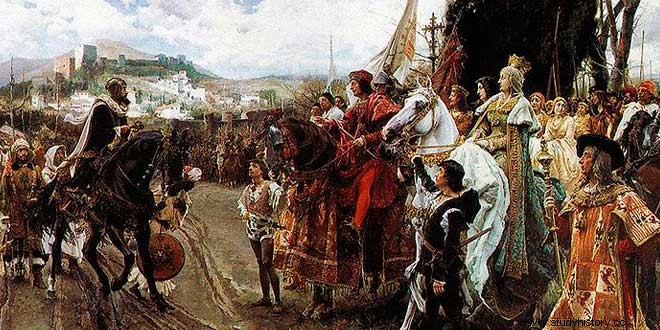
Uniting kingdoms
Isabel and Fernando, she with an amazing political instinct, he with his diplomatic astuteness and political wisdom —inspiring Machiavellianisms specially “manufactured” for the best European prince— thought of the value of family alliances for purposes of international interest. The Kings were the "owners" of the countries they ruled. Therefore, if the "owners" unite, if the family Houses reign, peace among the Christian princes is a fact. The children of Isabel and Fernando would connect Cortes with Cortes without having to go to war . They assigned their first-born Don Juan to Portugal, since his marriage to the heiress of that kingdom would achieve the long-awaited peninsular unity.
Unity of faith, expulsion of the Jews
Spanish unity was affirmed on two enormous pillars:the territory and the State without mediators. But religious unity and racial unity were still lacking. To achieve a faith without deviations, the obsessive propagation of Catholicism was indispensable. Hispanicized Muslims and Jews were respected in their beliefs. But something happened then that caused alarm in the sovereigns. The Mediterranean was swarming with Turkish and Barbary piracy. The Spanish coasts were almost closed to normal navigation, since the leagues for surveillance were many and the pirates seemed to have powerful auxiliaries inland. Both by their own conviction and to gain the trust of their subjects, the Catholic Monarchs, ignoring the respect for the Jews determined in the capitulations of Granada, published — 1492 — the expulsion order against the Hebrews . Unjustified and harmful expulsion for Spain, whose ultimate reason seemed to be the very special case of Santo Niño de la Guardia, murdered in a parody of crucifixion.
DiscoveryofAmerica
As if God wanted to reward the admirable ideals and work of Isabella and Fernando, in 1492, under the pressure of Castile and León (because Aragon and Catalonia, making reservations, had alleged, as Tarsicio de Azcona writes, «legal objections», «doubts technical", "practical difficulties"), the sailors from Moguer, captained and directed by Martín and Alonso Pinzón, embark on the adventure that Christopher Columbus has organized "like in dreams", trying to find the direct path between Western Europe and East Asia, which would shorten the commercial path of traffic of spices, so appreciated and well paid. For their part, the Andalusians of Huelva were sure that another land stood between Europe and Asia. The story of Alonso Sánchez de Huelva spread from word of mouth. The confluence of the two convictions — that of Columbus, on his way to Asia, that of the western Andalusians, new lands to seek — determined the discovery of the continent unhappily "baptized" as America. In which discovery Castile was used, which both mounts and Isabel, very thoroughly. Well, Castilla was African, oceanic above all, a friend of expanding, widening. The conquest of the Canary Islands had already marked this destiny many years before. But one must have great respect for the misgivings of the very acute Fernando, whose policy —closer, more “in sight”, long-standing and proven— was fully Mediterranean. Policy arrowed towards Italy, towards North Africa. Isabel, at the end of her life, seemed to understand, and share, this Fernandina policy, especially that referring to North Africa.
The announcement that they are discovered lands are very rich pushed thousands and thousands of Spaniards to the fabulous lands of America. The world whose door Isabel had opened will soon be too small for a Spain that will astonish and terrify the world.
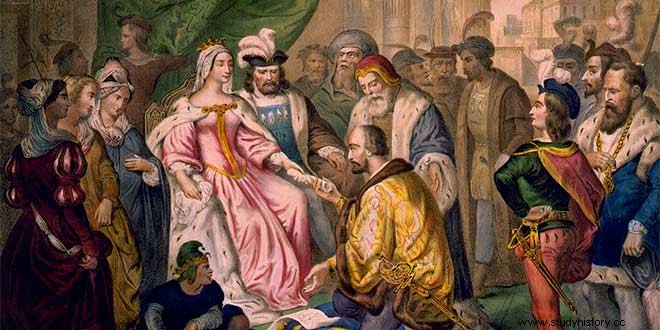
The holy inquisition
Before these events in 1478, the Pontiff Sixtus IV authorized the Catholic Monarchs to establish the Inquisition, so that it would rigorously ensure the maintenance of a chemically pure Catholicism in all national territories. The Jews owed their expulsion to this institution, and to its inquisitor general Fray Tomás de Torquemada . Even before, in the Cortes de Madrigal, in 1476, the Holy Brotherhood was founded, a meritorious institution dedicated to imposing tranquility in towns and roads, to ending the prevailing banditry, to breaking as many anarchies as could arise; the cuadrilleros —soldiers on horseback— of the Holy Brotherhood, constituted the most effective militias of internal government. Isabel imposed the Holy Brotherhood in Castilla y León. But Isabella and Fernando did not manage to impose it in the kingdoms of Aragon and Catalonia but "provisionally":imposed in 1488, it was abolished in 1510.
Forced conversion of muslims
The new companies of Isabel and Fernando were the creation of a permanent army; the stabilization of the Council of Castile; the imposition of an absolutely absolute monarchy; the incorporation to the Crown of the Military Orders; the conversion to Catholicism of all the Muslims who remained in Spain, a mission in which the famous Cardinal Mendoza and the no less famous Cardinal Francisco Jiménez de Cisneros helped the queen. This last undertaking motivated many Muslims — Moriscos — who wanted to preserve their religion, to take refuge armed in the Alpujarras, defending themselves until they met death. The Capitulation that was granted to them —in May of the year 1501— placed them before the dilemma of converting, even if it was "out of teeth", or leaving Spain . Such an impolitic measure motivated the departure from Spain of the most dedicated workers of their land:the Moors, some of whose crops are still preserved, unbeatable.
Danger in the succession
The last years lived by Queen Elizabeth I were certainly not links of rejoicing, but links of very deep sorrows. Her eldest daughter, Isabella, married first to Don Alfonso of Portugal, and when he died, he contracted a new marriage — 1497 — with his cousin, Don Manuel “the Fortunate”; but she died of giving birth to her first child, named Miguel. A year before, two weddings had been celebrated:that of Prince Don Juan of Castile with Margarita of Austria, and that of Doña Juana with the Archduke of Austria Don Felipe. On October 4, 1497, Prince Don Juan died in Burgos, leaving only one offspring of his blood:Prince Miguel . But this child died four years later. And only the princess Doña Juana, who had already begun to go mad, was left as heiress to “such great kingdoms”, but being maddened by love seemed to be natural madness, curable in a more or less long term. Therefore, Isabel's projects to set up a great European Family House failed. The succession was in danger, and she had to give Spain into foreign hands. The path of Africa was twisted by the violent pull that the unprecedented West gave. Spain was going to struggle with a task superior to her physical forces, and producing a new national anemia:the lack of young blood, wasted in America, and the lack of gold. The lack of proportion between effort and means, envy and predatory attacks from other powerful countries, even endangered the conservation of what was discovered at the price of precious blood.
Death of Isabel
But even when fortune "has done what it wanted, even if they did what they could" —as Quevedo could write—, from the glorious reign of Fernando and that tireless, heroic, tenacious even dying Isabel, they remained standing for the centuries of the centuries the National Unity, the enlightened religion and… America! No one can dispute the greater fame that the admiration of the world grants to this very unique woman, who one day in 1504 barely got off her horse —her famous white mare— at the door of an old mansion in Medina del Campo, falling in a faint. in the arms of his ladies. On November 26 of that year she gave her soul to God, while sitting at the head of her bed —No better testimony than the painting by Rosales—her husband Don Fernando, whose face already had something of a praying statue… Shortly before she died, Isabel dictated her will, a prodigy of discrimination, justice and fruitful love. In addition to a testament, it could be said that it is a treaty of good governance. To this will she added a codicil on November 3.
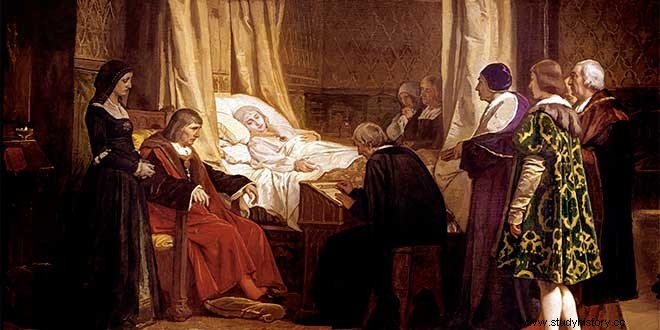
Testament
The main clauses of her will were:that she wanted to be buried in the Monastery of San Francisco, in Granada; that she wanted as many debts as she had contracted in her lifetime to be paid; that twenty thousand masses be applied to her in the convents and parishes of Spain and America ; that she instituted as heiress general of all her Kingdoms, Lands and Lordships, and of all her real estate, her much-loved daughter Doña Juana, Archduchess of Austria; prohibition of granting offices, both civil and ecclesiastical, to foreigners; that the Canary Islands would be assigned to the kingdom of Castile and León; that in the event of her daughter's incapacitation, the king, her lord, remain as governor of the kingdoms, until the infante Don Carlos, her grandson, reaches the age to govern them by himself; that demands that her successors not cease in the conquest of Africa and «fighting for the faith against the infidels»; that she wanted half of the revenues that arrived from America to be delivered to King Don Fernando; who distributed his jewels among his children and various monasteries, a donation to which he added this moving clause:«I beseech the King, my Lord, if he wants to use all the said jewels and things or those that most please his Lordship , because by seeing them I can have a more continuous memory of the singular love that I always had for your Lordship; and even because he always remembers that he has to die and that I wait for him in the next century, and with this memory he can die more holy and just »; that his testamentaries named Cisneros, Fonseca, Juan Velázquez, Fray Diego de Deza and Juan López de Carraga; that he ordered the completion of the construction of the royal chapel of Granada.
Codicil
The main clauses of the Codicil are these:that the income from Crusade, Orders and Encomiendas be used fairly; and... «I beseech the King my Lord very affectionately, that the neighboring Indians and inhabitants of the said Indies and Tierra Firme, won and to be won, do not receive any injury to their persons or property, but order that they be well and justly treaties» .
